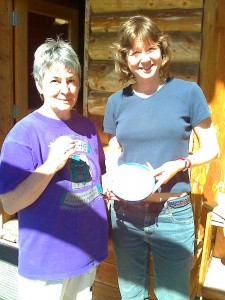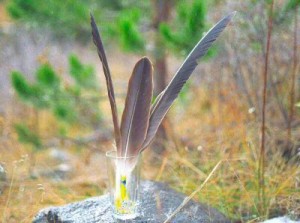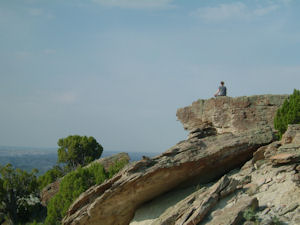Red-shafted flickers
I wasn’t completely off the mark when I thought my morning visitor was a woodpecker. The flickers are a type of woodpecker, but rather than pecking at bark to eat the grubs and insects underneath, they feed on ants and other ground insects, as well as berries in the winter time. I’d never seen one so close before, to notice the black breast-band. What has always struck me is their visual impact in flight, with their salmon-pink under-wings and white rump flashing, and their solid-looking shape. They have the up-and-down, undulating flight pattern shared by most woodpeckers.
When I was growing up my family owned land on Knouff Lake, northeast of Kamloops, BC. We spent a lot of time there, especially in the summer, staying in the one-room cabin that my father built. Bathing in the lake. No electricity or running water. (Many years later my dad put in power and phone.) We canoed around the lake, suntanned on the dock my dad built, swam, hiked, ate a lot of great food. One time bears tore into my sister’s and I’s tent, while the family was away on a day hike. There were paw prints on the windows of the cabin, too, more than 8 feet off the ground. Needless to say, Kim and I slept in the cabin that night, and learned not to hide goodies in the tent!
 When my dad learned he had brain cancer, in the late 1990s, he had to sell the property, and the family met there for a final farewell. It was a very sad visit, all of us struggling to come to terms with his cancer and impending death, and also losing this land that had meant so much to us. On the last day, as we were getting ready to leave, I went off for a short walk by myself, and found some beautiful orange feathers on the ground. They seemed like a miracle to me. I had never seen anything so magical as these brown feathers with white spots and patterns of orange on them. It was truly a gift from the land, a parting gift. I felt so moved and grateful to receive this goodbye from this place, a memento to keep with me always. I gave some of the feathers to my family, and kept one for myself. I have this feather still, and it is in the north on my altar—the place of my people, and a symbol of the air element.
When my dad learned he had brain cancer, in the late 1990s, he had to sell the property, and the family met there for a final farewell. It was a very sad visit, all of us struggling to come to terms with his cancer and impending death, and also losing this land that had meant so much to us. On the last day, as we were getting ready to leave, I went off for a short walk by myself, and found some beautiful orange feathers on the ground. They seemed like a miracle to me. I had never seen anything so magical as these brown feathers with white spots and patterns of orange on them. It was truly a gift from the land, a parting gift. I felt so moved and grateful to receive this goodbye from this place, a memento to keep with me always. I gave some of the feathers to my family, and kept one for myself. I have this feather still, and it is in the north on my altar—the place of my people, and a symbol of the air element.
I didn’t learn until I was studying ecopsychology at Naropa University, in Boulder, Colorado, and walking to school with a fellow Canuck, that the birds with the orange under-wings are called flickers. Before I even knew what these birds were called I found some flicker feathers on a trip to Boulder, down by the Boulder Creek. I was in Boulder for a weekend workshop on rites of passage, and one night went on a special medicine walk to learn about what the threshold means—one of the three stages of a rite of passage. I had overcome my fear and gone into the creek in the dark, symbolically leaving behind my old self as I crossed through the icy water. I laugh to myself now, remembering how I was afraid the water was so cold it would freeze my legs and I wouldn’t be able to get back to the motel I was staying at! I made it home alive, and the next morning I found a pair of lovely orange feathers down by the creek. These are on my altar now too.
Ted Andrews, in his wonderful book Animal Speak says that the flicker signifies new rhythms of growth and healing love. It usually reflects that the stimulation of latent talents is going to be a catalyst for major creative changes in your life. Right now I believe that doing this blog is opening up some writing energy that has been blocked for years, and I am very excited to see what will emerge through this activity!
I have found a few other flicker feathers over the years, and they always feel special to me. And then, the morning before I visited with the flicker on my balcony, I found an orange-tinted feather on the ground below the balcony. My first gift from the flicker on this land. I felt like this place is truly my home now. It has been marked. It has been acknowledged. The land and her creatures agree.
 surprised to hear the unexpected visitors I’ve had at Monkey Valley. One time I was coming back from a run to the 5 KM marker—a favourite out-and-back route that takes about 45 minutes—and found two men in hunters’ gear on the wrong side of the fence at the top gate. They were standing behind the signs that said No Hunting and No Trespassing. Luckily I was feeling strong and confident with all the blood charging around my body from the run, so I grilled them, beginning with:
surprised to hear the unexpected visitors I’ve had at Monkey Valley. One time I was coming back from a run to the 5 KM marker—a favourite out-and-back route that takes about 45 minutes—and found two men in hunters’ gear on the wrong side of the fence at the top gate. They were standing behind the signs that said No Hunting and No Trespassing. Luckily I was feeling strong and confident with all the blood charging around my body from the run, so I grilled them, beginning with:




 nature. In North America, the plains peoples are the most well-known groups to use the ancient practice of the vision quest. John Murray recounts, in editors Michael Tobias and Georgianne Cowan’s
nature. In North America, the plains peoples are the most well-known groups to use the ancient practice of the vision quest. John Murray recounts, in editors Michael Tobias and Georgianne Cowan’s 



